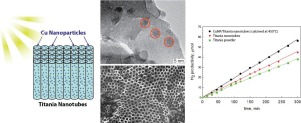Catalysis Today ( IF 5.2 ) Pub Date : 2017-08-25 , DOI: 10.1016/j.cattod.2017.08.036 F. Tavella , C. Ampelli , L. Frusteri , F. Frusteri , S. Perathoner , G. Centi

|
Titania nanotube (TNT)-array thin films well decorated by copper nanoparticles with average size of 3 nm were prepared by spray coating of a solution containing size-controlled Cu0 nanoparticles. The consecutive calcination at 300 °C and 450 °C leads to the oxidation of these Cu NPs to CuO, with small amounts of Cu2O at the lower calcination temperature, but maintaining the high dispersion. Analogous materials prepared by copper electrodeposition lead to significantly larger Cu NPs. The TNT-array thin film shows significantly enhanced photocurrent (up to about 90%) with respect to a comparable thin film prepared by spin coating using a commercial TiO2 P25 sample. The behavior is similar by applying different filters to cut part of solar light simulator radiation. Particularly, using an UV B/C blocking filter, which permits to pass light in the 350–550 nm range, an about two-fold intensification in the current-to-electrical energy conversion (normalized to the same total irradiance) is obtained. The presence of CuO nanoparticles decreases the photocurrent density with respect to the support alone (TNT-array 1h), but enhances the H2 photogeneration rate in the gas-phase photoreactor experiments. The results indicate that in the tested experimental conditions, the main role of CuO nanoparticles is to act as co-catalyst to improve the H2 photogeneration rate rather than to promote charge separation or other effects, which promote the photocurrent density.
中文翻译:

在垂直排列的纳米管的二氧化钛薄膜上开发基于铜基纳米粒子的光电催化太阳能电池用光阳极
通过喷涂包含尺寸可控的Cu 0纳米颗粒的溶液,制备了平均粒径为3 nm的铜纳米颗粒很好装饰的二氧化钛纳米管(TNT)阵列薄膜。在300°C和450°C下连续煅烧会导致这些Cu NPs氧化为CuO,在较低的煅烧温度下会有少量的Cu 2 O,但仍保持较高的分散度。通过铜电沉积制备的类似材料会导致更大的Cu NP。与通过使用市售TiO 2旋涂制备的可比较薄膜相比,TNT阵列薄膜显示出显着增强的光电流(高达约90%)。P25样品。通过应用不同的滤镜来削减部分太阳光模拟器辐射,其行为是相似的。特别是,使用UV B / C阻挡滤光片,该滤光片可使350-550 nm范围内的光通过,在电流到电能的转换中得到大约两倍的强度增强(归一化为相同的总辐照度)。相对于单独的载体(TNT阵列1h),CuO纳米粒子的存在降低了光电流密度,但在气相光反应器实验中却提高了H 2的光生速率。结果表明,在测试的实验条件下,CuO纳米颗粒的主要作用是充当助催化剂以改善H 2 光生速率而不是促进电荷分离或其他作用,从而促进光电流密度。











































 京公网安备 11010802027423号
京公网安备 11010802027423号